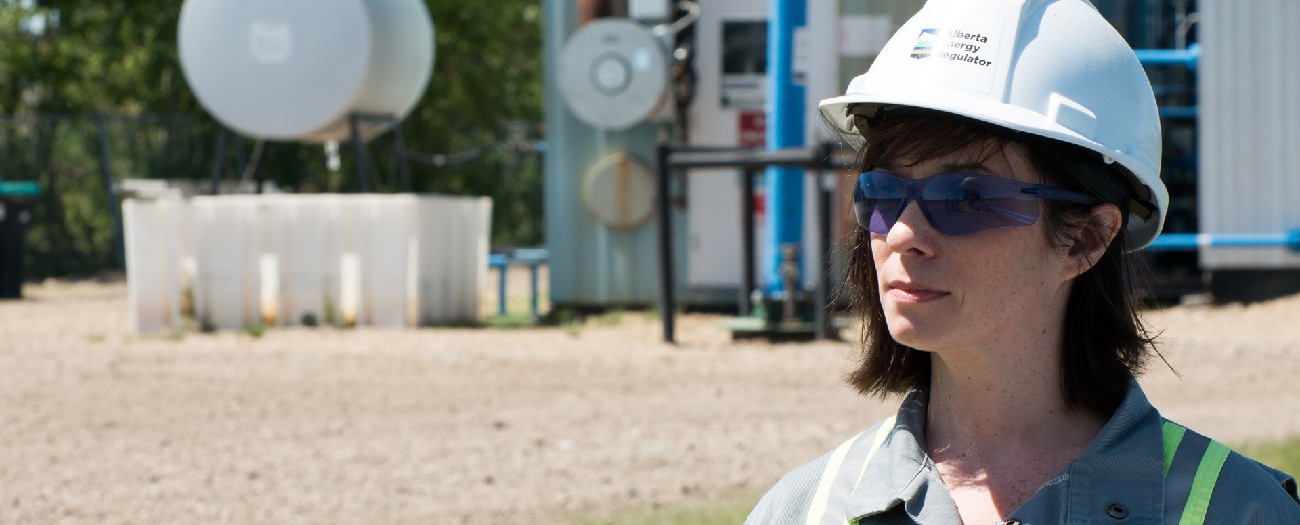Background
Rondine Cabot’s story represents one of the 11,216 inspections the AER conducted in fiscal 2015-16. AER staff wield significant power when it comes to ensuring Alberta’s energy industry follows the rules and industry personnel recognize that.
Rondine Cabot, a 10-year veteran of the AER’s inspection team, drops her four-year-old daughter off at daycare and climbs into her pickup to begin her commute to work. But today’s drive isn’t into her office in Edmonton; she’ll be driving for three hours this morning to check on a high-risk sour gas facility near Fox Creek and an indigenous reserve.
Two days earlier, Cabot began her intensive investigation into the facility by checking Government of Alberta software programs to understand the full scope of the operation. She reviewed the company’s Water Act approval to identify the company’s maximum withdrawal rate so she could verify it during the inspection, and checked for any environmental protection conditions the company must meet above and beyond the standard requirements.
Cabot also combed through old records to see where the energy operator had been deficient in the past, if there had been any complaints from the public about it, and how they’d fixed those problems.
“We look at everything,” she said. “We start with anything that may affect public safety and go from there.”
Those old inspection and complaint records are kept in an AER software program that details every piece of energy infrastructure in the province, whether it’s an abandoned well or pipeline or a currently operating facility. The program also helps Cabot and the other AER inspectors focus on the wells, pipelines, mines, and facilities that pose the greatest threat to Albertans or the environment. It’s identified this facility as high risk because it processes a high concentration of lethal sour gas.
As Cabot makes her way northwest, she considers her plan of action for inspecting the site. The most important thing she’ll look for: that the company has measures in place to protect the public and environment if something goes wrong.
“When I first get to a site, I look at the signage so the public can call them to respond if there’s an emergency,” Cabot said. “People need to know whose facility it is without having to go on the site.”
Cabot pulls off the highway onto gravel roads toward the facility, knowing that although she’s here to inspect the facility, if there’s an oil and gas emergency nearby, she’ll be responding to that instead. She needs to be able to
react at a moment’s notice to energy incidents.
“If there’s an emergency the first thing we do is make sure the operator has enacted their emergency response plan. But we always send the person that’s closest to respond.”
And sometimes that means helping out other field offices if the emergency is near the office boundaries.
“We have the flexibility to go where we see the need,” she added.
Thankfully, major incidents in the energy industry are rare; there were just four well blowouts and 1.5 pipeline spills for every 1000 km of pipeline in the province in 2015. And on this day, Cabot makes it to the sour gas facility without being called away.
As she inches her way up the rutted, muddy lease road in her pickup, our logo—the shield depicting Alberta’s diverse landscape and bold black letters spelling out Alberta Energy Regulator—is immediately recognizable to the men in blue coveralls and hard hats working at the plant. And as Cabot steps out of her truck in her light grey, AER branded personal protective equipment; she stands out in stark contrast.
She makes her way to the office on site. The plant manager stands from his desk, shakes her hand and introduces himself.
“We’re usually received by operators very well,” Cabot says. “There have maybe been two times in my 10 years that I haven’t been.
“They understand my job isn’t to get people into trouble; it’s to help them find areas where they can improve. Whether it’s because of the impact to the public or environment or because of the cost to clean it up, nobody wants spills to happen.”
So the inspection begins and Cabot has become the leader of the pack.
“They usually like to walk around the site with us to see what it is we’re looking for; to make sure that they’re following the rules.”
Nearly four hours later, after explaining numerous AER requirements to the operators, Cabot’s inspection is complete. The facility has some minor deficiencies, but nothing that put the public at risk. She’ll have to check in on them again soon to make sure they’ve been fixed.
And if it’s not?
“We have the authority to shut a company down. There are a lot of tools at our disposal to make sure energy companies follow the rules; warnings, more inspections of their facilities, fines.
“But one of the most effective ways is to shut them in. If they can’t produce, they can’t make any money. And that’s a big incentive to follow the rules.”
Ryan Bartlett, Writer


